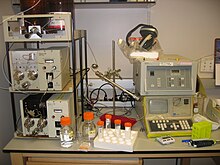 Introduction
IntroductionThe construction of chromatographic fingerprints plays an important role in the quality control of complex herbal medicines. Chemical fingerprints obtained by chromatographic techniques are strongly recommended for the purpose of quality control of herbal medicines, since they might represent appropriately the “chemical integrities” of the herbal medicines and therefore be used for authentication and identification of the herbal products. Based on the concept of phytoequivalence, the chromatographic fingerprints of herbal medicines could be utilized for addressing the problem of quality control of herbal medicines. By definition, a chromatographic fingerprint of a herbal medicine is, in practice, a chromatographic pattern of pharmacologically active and or chemically characteristic constituents present in the extract. This chromatographic profile should be featured by the fundamental attributions of “integrity” and “fuzziness” or “sameness” and “differences” so as to chemically represent the herbal medicines investigated. This suggest that chromatographic fingerprint can successfully demonstrate both “sameness” and “differences” between various samples and the authentication and identification of herbal medicines can be accurately conducted even if the number and/or concentration of chemically characteristic constituents are not very similar in different samples of herbal medicine. Thus chromatographic fingerprint should be considered to evaluate the quality of herbal medicines globally considering multiple constituents present in the herbal medicines.
Need for development of chromatographic fingerprints:
Herbal medicines have a long therapeutic history and are still serving many of the health needs of a large population of the world. But the quality control and quality assurance still remains a challenge because of the high variability of chemical components involved. Herbal drugs, singularly and in combinations, contain a myriad of compounds in complex matrices in which no single active constituent is responsible for the overall efficacy. This creates a challenge in establishing quality control standards for raw materials and standardization of finished herbal drugs. Traditionally only a few markers of pharmacologically active constituents were employed to assess the quality and authenticity of complex herbal medicines. However, the therapeutic effects of herbal medicines are based on the complex interaction of numerous ingredients in combination, which are totally different from those of chemical drugs. Thus many kinds of chemical fingerprint analysis methods to control the quality of herbal drugs have gradually come into being, such as thin layer chromatography, gas chromatography, high performance liquid chromatography etc. chromatographic fingerprint analysis of herbal drugs represents a comprehensive qualitative approach for the purpose of species authentication, evaluation of quality and ensuring the consistency and stability of herbal drugs and their related products. The entire pattern of compounds can then be evaluated to determine not only the presence or absence of desired markers or active constituents but the complete set of ratios of all detectable analytes. The chemical fingerprints obtained by chromatographic and electrophoretic techniques, especially by hyphenated chromatographies, are strongly recommended for the purpose of quality control of herbal medicines, since they might represent appropriately the “chemical integrities” of herbal medicines and therefore be used for authentication and identification of the herbal products.
Difficulties in development of chromatographic fingerprints for herbal medicines
When herbal drugs are considered for analysis, a large number of chemical components are involved and many of them are in low concentration. Chromatographic instruments and experimental conditions are difficult to reproduce during real analysis. Thus, the baseline and retention time shifts surely will be in existence from one chromatogram to another. Many other problems associated with chromatographic fingerprints such as the occurrence of abnormal chromatograms from outlying herbal samples or experiments inevitably will be encountered. As a result, in order to obtain reliable chromatographic fingerprints, several data treatments would be needed during fingerprint analysis.
Chemometric approaches and data processing for chromatographic fingerprint of herbal medicines:
Due to complexity of the chromatographic fingerprint and the irreproducibility of chromatographic instruments and experimental conditions, several chemometric approaches such as variance analysis, peak alignment, correlation analysis, and pattern recognition were employed to deal with the chromatographic fingerprint. Many mathematical algorithms are used for data processing in chemometric approaches. The basic principles for this approach are variation determination of common peaks/ regions and similarity comparison with similarity index and linear correlation coefficient. Similarity index and linear correlation coefficient can be used to compare common pattern of the chromatographic fingerprints obtained. In general, the mean or median of the chromatographic fingerprints under study is taken as the target and both are considered to be reliable. To facilitate the data processing, a software named Computer Aided Similarity Evaluation (CASE) has been developed. All programs of chemometric algorithms for CASE are coded in METLAB5.3 based on windows. Data loading, removing, cutting, smoothing, compressing, background and retention time shift correction, normalization, peak identification and matching, variation determination of common peaks/regions, similarity comparison, sample classification, and other data processes associated with the chromatographic fingerprint can be investigated with this software.
EXAMPLES:
6.1 HPTLC fingerprinting analysis of Adhatoda vasica Nees. :
Vasicine and vasicinone type alkaloids are separate from the Adhatoda vasica Nees.
HPTLC fingerprinting shows the presence of five peaks. Two of them, which are major, correspond to vasicine and vasicinone with superimposable UV spectrum.
a) System :
CAMAG Instrument
Automatic Plate Quoter
Linomat-5
Chromatogram Scanner with Wincats
Software
b) Operating Conditions:
- Mobile Phase : Methanol-Toluene-Dioxane-Ammonia (2:2:5:1)
- Wavelength : 270 nm
- Slit Width : 5 x 0.45 nm
- Lamp Used : D2 and W
- Scan Mode : Absorption-Reflection
HPTLC fingerprint shows the presence of five peaks. Two of them, which are major, correspond to vasicine and vasicinone ( Rf 0.99 and 1.17) with superimposable UV-Spectrum.
2. Finger printing profile on Laboratory and market formulation of Rajanyadi churna was estimated by using HPTLC.
Both Photographs showing the comparative account of presence of various phytoconstituents in direct Methanolic extract of different plants incorporated to that of the lab and marketed formulations. Rf values of different constituents of individual plant Methanolic extracts are matching with the Rf values of formulation Methanolic extracts.
3. HPTLC Fingerprint Identification of Commercial Ginseng Medicine :
- The roots of Ginseng have held the esteem of the Chinese as a “ cure-all medicinal herb for thousands of years. It turns out. Nowadays, in single or multi component pill, tablet, capsule, oral liquid and even cosmetics besides the crude drug itself. Commercial Ginseng is Classified in to white ginseng (dried naturally), red ginseng (steam-processed) (Panax ginseng, family; Araliaceae) produced mainly in china and Korea ( it can therefore be called ‘ Asian ginseng’); American Ginseng (P. quinquifolium) exported from eastern U.S.A and Canada via Hongkong as well as Notoginseng (Sachi) (P.notoginseng) native of South west China. A booming Market in Asian Ginseng, American Ginseng and various kinds of their preparations recent years put forward before the analysis a task for quality control with an effective, rapid and economic analysis method. As routine drug control, TLC/ HPTLC does undoubtedly meet the requirements and the fingerprint differentation taps further the potential of TLC from the view- Point of methodology.
- As routine quality control of commercial Ginseng medicine, TLC/HPTLC is no doubt a rapid, effective and low-cost analytical method. HPTLC of Asian ginseng, American Ginseng, Notogineseng (Sanchi) and some of their preparations have been reported by Xie and Yan reliable experimental data and the reproducible chromatograms.
- It has been reported that upon comprehension of more than hundreds of specimens of commercial radix Asian Ginseng [ Panax ginseng] and American Ginseng [ P. quinquifolium], as a whole, the HPTLC pattern of Ginseng are always simpler than that of Asian Ginseng. The fluorescence intensity of mani ginsenosides sports is much stronger than the miner saponin spots. In comtrast with American Ginseng, the minor ginsenosides in Asian Ginseng (red ginseng in particular) are easier to observe and the patterns are therefore mor complicated.
- To optimize the condition of HPTLC and ginsenosides it has been reported that the solvent system, chloroform-Ethyl acetate-
Methanol-Water (15/40/22/10, stand over night at 8-100C(lower phase) has a highr resolution, better reproducibility of Rf values and more impact spots by comparison with the solvent systems established by the previous investigators and used in common. Detection and scanning in fluorescence mode after visualization with 5 % sulphuric acid/EtOH reagent by dipping technique improved and enhanced the sensitivity than that in absorbance mode most commonly used.
- Sample pretreatment through adsorption clean-up step via a small basic alumina column followed by 1-butanol extraction instead of only butanol-extraction step made the chromatogram more clear, less background contamination and reduced the trailing of some ginsenosides spots. The experimental data demonstrated that the relative humidity(RH) has significant influence on the chromatographic behavior of ginseosides. The optimum RH for pre-equilibration of the precoated HPTLC plate is 42-47 % and the optimum temperature of development is at 25-280 C.
- HPTLC fingerprints of ginseng preparations revealed the instability of ginsenosides in liquid dosage forms such as “shuan Bao Su” oral liquid (SBS-Liq) containing royal jelly and honey in admixture with ginseng extract. These findings raise questions about assessment of the stability of ginseng preparations from the standpoint of drug quality control. The results of an accelerated stability study reported by Xie and Yan elucidate the varius degradation processes of ginsenosides in the presence of royal jelly and/or honey. It also demonstrates that the HPTLC ginsenosides fingerprint can serve as stability indicating method, even when the chromatogram is not otherwise differentiated.


0 comments:
Post a Comment